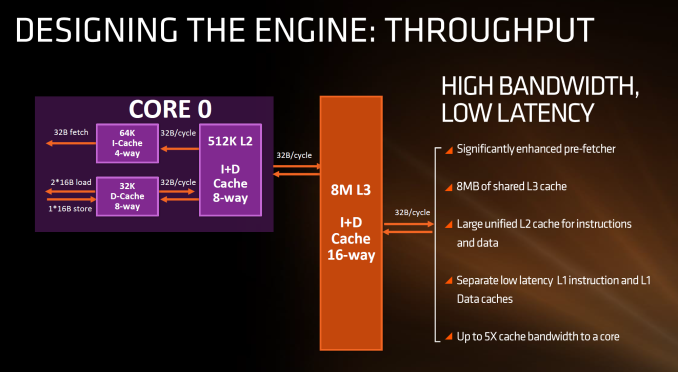AMD Zen Microarchitecture: Dual Schedulers, Micro-Op Cache and Memory Hierarchy Revealed
by Ian Cutress on August 18, 2016 9:00 AM ESTDeciphering the New Cache Hierarchy
The cache hierarchy is a significant deviation from recent previous AMD designs, and most likely to its advantage. The L1 data cache is both double in size and increased in associativity compared to Bulldozer, as well as being write-back rather than write-through. It also uses an asymmetric load/store implementation, identifying that loads happen more often than stores in the critical paths of most work flows. The instruction cache is no longer shared between two cores as well as doubling in associativity, which should decrease the proportion of cache misses. AMD states that both the L1-D and L1-I are low latency, with details to come.
The L2 cache sits at half a megabyte per core with 8-way associativity, which is double that of Intel’s Skylake which has 256 KB/core and is only 4-way. On the other hand, Intel’s L3/LLC on their high-end Skylake SKUs is at 2 MB/core or 8 MB/CPU, whereas Zen will feature 1 MB/core and both are at 16-way associativity.
Edit 7:18am: Actually, the slide above is being slightly evasive in its description. It doesn't say how many cores the L3 cache is stretched over, or if there is a common LLC between all cores in the chip. However, we have recieved information from a source (which can't be confirmed via public AMD documents) that states that Zen will feature two sets of 8MB L3 cache between two groups of four cores each, giving 16 MB of L3 total. This would means 2 MB/core, but it also implies that there is no last-level unified cache in silicon across all cores, which Intel has. The reasons behind something like this is typically to do with modularity, and being able to scale a core design from low core counts to high core counts. But it would still leave a Zen core with the same L3 cache per core as Intel.
| Cache Levels | ||||
| Bulldozer FX-8150 |
Zen | Broadwell-E i7-6950X |
Skylake i7-6700K |
|
| L1 Instruction | 64 KB 2-way per module |
64 KB 4-way | 32 KB 8-way | 32 KB 8-way |
| L1 Data | 16 KB 4-way Write Through |
32 KB 8-way Write Back |
32 KB 8-way Write-Back |
32 KB 8-way Write-Back |
| L2 | 2 MB 16-way per module |
512 KB 8-way | 256 KB 8-way | 256 KB 4-way |
| L3 | 1 MB/core 64-way |
1 or 2 MB/core ? 16-way |
2.5 MB/core 16/20-way |
2 MB/core 16-way |
What this means, between the L2 and the L3, is that AMD is putting more lower level cache nearer the core than Intel, and as it is low level it becomes separate to each core which can potentially improve single thread performance. The downside of bigger and lower (but separate) caches is how each of the cores will perform snoop in each other’s large caches to ensure clean data is being passed around and that old data in L3 is not out-of-date. AMD’s big headline number overall is that Zen will offer up to 5x cache bandwidth to a core over previous designs.











216 Comments
View All Comments
SunnyNW - Thursday, August 18, 2016 - link
Looks like the early leak (AOTS) is more/less correct at least for the ES...at the presentation they had the 8c/16t part running at 3ghz.StormyParis - Thursday, August 18, 2016 - link
"Firstly,"I object bigly to that word.
psurge - Thursday, August 18, 2016 - link
Ian - I think there's a mistake on the first page. As far as I know, AGUs do not perform loads and stores, they calculate load/store addresses. It strikes me as interesting that Zen can perform memory operations more quickly (3 per cycle) than it can generate addresses for them (2 per cycle, per the diagram).KaarlisK - Thursday, August 18, 2016 - link
"some put it as a major stepping stone for Conroe"Err, wasn't it Sandy Bridge?
MrSpadge - Thursday, August 18, 2016 - link
Good catch, I think you're right.silverblue - Thursday, August 18, 2016 - link
I thought Conroe's ace was its four-issue front end; AMD didn't have that ability until Bulldozer.farmergann - Thursday, August 18, 2016 - link
Did anyone else notice AMD's Zen has 2x GCN CUs? LOL, this is how they managed to trump broadwell-e in Blender. Slightly dishonest since they didn't mention that, but I'm proud of them for showing some competitive fire!Ian Cutress - Saturday, August 20, 2016 - link
Source?patel21 - Thursday, August 18, 2016 - link
For me, a performance comparable to i3 skylake, with power requirements at max over 20% of i3, with a good gpu integrated and at around 70% of i3's price. And My boat will sail AMD....Ho yaaiwod - Thursday, August 18, 2016 - link
Assuming no major bugs, or I/O ( AMD has ALWAYS HAD problem with I/O controller ), Zen should do very well in Server market.Yes there is Pref/ Watt, but when you compound it in the Server power usage from other component, I think Zen should be favourable to many. ( Assuming Intel dont massively drop price )